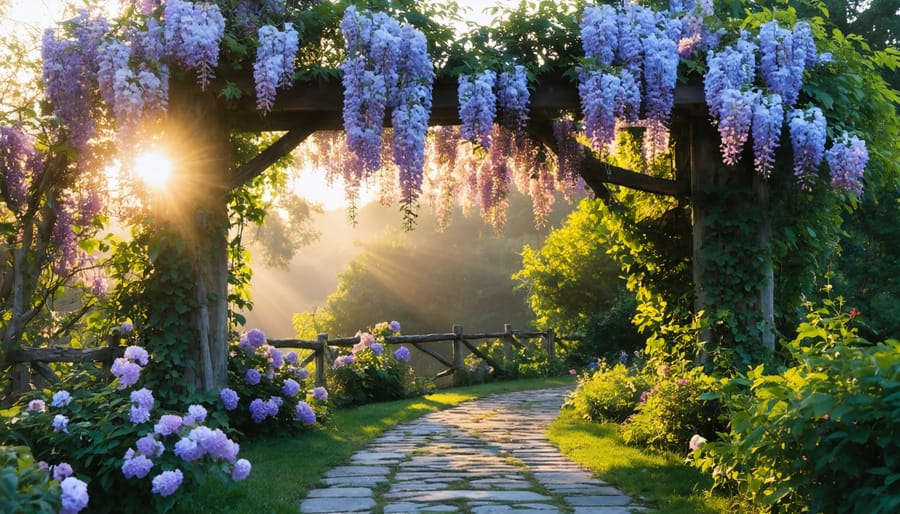Transform your outdoor space by mastering the art of strategic landscape design. Start with a thorough site analysis – mapping sunlight patterns, soil conditions, and existing vegetation creates the foundation for every successful garden. Layer your plantings vertically, combining towering trees, mid-height shrubs, and ground covers to create depth and visual interest while maximizing limited space. Establish clear focal points using striking elements like water features, specimen plants, or architectural structures to guide the eye and create a sense of purpose in your design.
Beautiful gardens work in harmony with nature, not against it. Group plants with similar water needs together, incorporate native species that support local wildlife, and use natural slopes to your advantage. This thoughtful approach reduces maintenance, conserves resources, and creates a resilient landscape that thrives through changing seasons.
Whether you’re designing a compact urban garden or sprawling country estate, these fundamental strategies ensure your landscape tells a cohesive story. By combining practical functionality with artistic vision, you’ll create an outdoor sanctuary that delights the senses while serving your everyday needs.
Creating Your Garden’s Visual Flow
The Power of Focal Points
Creating focal points in your garden is like composing a masterpiece where your eye naturally gravitates toward certain enchanting garden features. These attention-grabbing elements serve as anchors that bring harmony and structure to your outdoor space. Think of them as the stars of your garden show, with supporting elements playing complementary roles.
To establish effective focal points, start by identifying natural viewing positions – perhaps from your patio, kitchen window, or garden entrance. Place your standout features where they’ll catch the eye from these vantage points. A stunning specimen tree, an artistic sculpture, or a charming water feature can serve as primary focal points.
Remember the rule of thirds when positioning these elements. Imagine your garden divided into a grid of nine equal squares, and place focal points where the lines intersect. This creates a more dynamic and visually appealing layout than centering everything.
Layer your focal points with complementary plantings that draw attention inward. For example, surround a beautiful stone fountain with graduating heights of flowers, starting with low-growing varieties in front and taller plants behind. This creates a natural flow that guides the eye exactly where you want it to go.
Don’t overdo it – too many focal points can create visual chaos. Instead, choose one main feature for each distinct garden area, allowing each to shine without competition.

Balance and Proportion
Creating visual harmony in your landscape starts with understanding balance and proportion, two fundamental principles that can transform your garden from ordinary to extraordinary. Think of your garden as a living canvas where every element plays a crucial role in the overall composition.
Symmetrical balance, achieved by mirroring plants and features on either side of a central point, creates a formal, elegant feel. For example, flanking your front walkway with matching boxwood shrubs or identical flowering perennials instantly establishes a sense of order and sophistication. However, don’t feel constrained by perfect symmetry – asymmetrical balance can be equally effective and often feels more natural.
When working with asymmetrical balance, focus on the visual weight of different elements. A large flowering shrub on one side can be balanced by a cluster of smaller plants or a decorative feature on the other. Consider factors like plant height, spread, color intensity, and texture when creating these informal arrangements.
Proportion is about the size relationship between different elements in your garden. A good rule of thumb is to keep plant heights to about one-third the height of your house near the foundation. As you move further into the landscape, gradually increase plant heights to create depth and interest. Remember to consider how plants will look at maturity – that cute little sapling might overwhelm your space in a few years!
Layer your plantings from tall to short, creating a gentle transition that guides the eye through your landscape. This natural progression helps maintain visual harmony while ensuring smaller plants aren’t lost behind larger ones.
Smart Space Planning

Activity Zones
A well-designed garden should include distinct zones that cater to different activities, making your outdoor space both functional and enjoyable. Start by identifying how you want to use your garden – whether it’s for entertaining, growing food, or to create peaceful garden spaces for relaxation.
Consider creating these essential zones:
Entertainment Area: Designate a space for gathering with friends and family. This might include a patio or deck with comfortable seating, perhaps centered around a fire pit or outdoor kitchen. Ensure this area is easily accessible from your home and has adequate lighting for evening use.
Dining Space: If you enjoy outdoor meals, create a dedicated dining area with proper shade protection. Position it close to your kitchen for convenient food service, and consider adding weather-resistant furniture and perhaps a pergola for comfort.
Growing Zone: For vegetable gardens and herb patches, choose a sunny spot with good soil and easy access to water. Raised beds can help define this space while making maintenance more manageable.
Children’s Play Area: If you have young family members, incorporate a safe play zone within view of the house. Use soft ground covers and ensure proper spacing from more delicate garden features.
Quiet Retreat: Everyone needs a peaceful spot to unwind. This might be a secluded bench surrounded by fragrant flowers or a small meditation garden with gentle water features.
Remember to connect these zones with clear pathways and use plantings or decorative elements to create natural transitions between areas. This zoning approach helps maximize your garden’s potential while ensuring each space serves its intended purpose effectively.
Traffic Flow Solutions
Creating a natural flow through your garden is essential for both functionality and enjoyment. Think of your garden paths as silent guides, leading visitors on a journey through your outdoor space. The key is to design pathways that feel intuitive and inviting while serving practical purposes.
Start by observing how people naturally move through your space. Notice the informal paths that have already formed – these “desire lines” often indicate the most logical routes. When planning your paths, consider both primary routes (main walkways) and secondary paths (casual garden strolls).
Width matters significantly in traffic flow. Main pathways should be at least 4-5 feet wide, allowing two people to walk comfortably side by side. Secondary paths can be narrower, around 2-3 feet, creating a more intimate experience. Remember to account for maintenance equipment access when needed.
Materials play a crucial role in directing movement. Use consistent materials for main routes to provide clear visual cues. Consider using stepping stones, gravel, or pavers that complement your garden’s style while remaining practical in all weather conditions.
Create points of interest along your paths to enhance the journey. This might include a charming bench around a corner, a sculptural element, or a fragrant plant that encourages visitors to pause and engage with the space. These focal points help break up long stretches and make the journey more engaging.
Don’t forget about lighting – it’s essential for safety and evening enjoyment. Solar-powered path lights or low-voltage lighting systems can illuminate the way while adding ambiance to your garden after dark.
Curves in pathways create a sense of mystery and encourage exploration, but avoid unnecessary meandering that might frustrate visitors trying to reach a destination quickly. The goal is to balance efficiency with experience.
Plant Selection Strategy
Layering Techniques
Layering plants in your landscape is like composing a beautiful photograph – each layer adds depth and intrigue to your garden’s story. Start by imagining your garden space in three distinct layers: ground cover, middle-height plants, and tall statement pieces. This approach not only creates visual interest but also maximizes your garden’s potential.
Begin with low-growing ground covers that carpet the earth, such as creeping thyme or sweet woodruff. These plants prevent weed growth while adding texture at the garden’s foundation. In the middle layer, incorporate perennials and smaller shrubs that reach between 2-4 feet tall. Think salvias, daylilies, or compact hydrangeas – plants that provide both structure and seasonal interest.
The back layer is your garden’s dramatic backdrop. Tall ornamental grasses, climbing roses on trellises, or stately evergreens create a sense of enclosure and privacy. Remember to consider each plant’s mature size when planning your layers to avoid overcrowding.
For the most striking effect, overlap your layers slightly rather than creating rigid lines. This natural transition between heights mimics patterns found in nature and creates a more cohesive look. Don’t forget to include plants with varying bloom times in each layer – this ensures your garden remains interesting throughout the growing season.
A well-executed layering strategy transforms flat spaces into dynamic, three-dimensional gardens that draw the eye and invite exploration.

Year-Round Appeal
Creating a garden that captivates throughout the year requires thoughtful season-by-season garden planning. The key is to think beyond just spring blooms and summer colors, incorporating elements that shine in every season.
Start by selecting plants with varying bloom times. Early spring bulbs like snowdrops and crocuses can peek through late winter snow, while summer perennials keep the show going. For autumn, ornamental grasses and late-blooming asters add movement and color. Even winter can be stunning with evergreens, berry-producing shrubs, and plants with interesting bark or structure.
Consider incorporating hardscape elements that look beautiful year-round. Decorative pathways, architectural features, and well-placed garden art create focal points that maintain visual interest even when plants are dormant. Water features can transform into ice sculptures during winter months, adding unexpected beauty to the cold season.
Layer your plantings with different heights and textures. Combine deciduous trees that provide spring flowers and fall color with evergreen shrubs that offer winter structure. Add lower-growing perennials and groundcovers that change appearance throughout the seasons. Don’t forget to include plants with interesting seed heads or dried stalks that add winter interest and provide food for local wildlife.
Remember, successful year-round gardens rely on careful plant selection and strategic placement. Take notes throughout the year to identify gaps in seasonal interest and adjust your design accordingly.
Sustainable Design Elements
Water-Wise Planning
Water conservation is becoming increasingly important in modern landscape design, and implementing smart water management strategies can help create beautiful gardens that are both sustainable and low-maintenance. Start by grouping plants with similar water needs together, a technique known as hydrozoning. This simple yet effective approach, recommended in many expert gardening tips, ensures that no plant receives too much or too little water.
Consider installing a drip irrigation system, which delivers water directly to plant roots, reducing waste through evaporation. Mulching is another water-wise practice that helps retain soil moisture and suppress thirsty weeds. Aim for a 2-3 inch layer of organic mulch around your plants.
Choose drought-resistant plants native to your region, as they’re naturally adapted to local rainfall patterns. Consider replacing portions of your lawn with water-efficient alternatives like groundcovers or xeriscaping features. Adding rain barrels to collect roof runoff provides a free water source for your garden while reducing stormwater runoff. Remember, successful water-wise planning doesn’t mean sacrificing beauty – it’s about making smart choices that benefit both your garden and the environment.
Native Plant Integration
Incorporating native plants into your landscape design isn’t just a trend – it’s a smart, sustainable choice that brings multiple benefits to your garden. These local heroes are already adapted to your climate and soil conditions, meaning they’ll require less water, fertilizer, and maintenance than non-native species.
Start by researching plants that naturally grow in your region. Local nurseries and native plant societies are excellent resources for discovering which species will thrive in your area. Consider incorporating layers of native plants, from ground covers to shrubs and trees, to create a natural ecosystem that supports local wildlife.
When selecting native plants, think about their seasonal features. Choose a mix of species that provide year-round interest through flowers, berries, fall colors, and winter textures. Group plants with similar water needs together to create efficient watering zones.
Remember that native plants support local pollinators and birds, creating a vibrant habitat right in your backyard. They also help prevent soil erosion and typically have deeper root systems that improve soil structure. By choosing native species, you’re not just creating a beautiful garden – you’re contributing to your local ecosystem’s health and sustainability.
As we’ve explored throughout this guide, successful landscape design is a beautiful blend of art and science, creativity and planning. By following the strategies we’ve discussed – from understanding your space and local climate to selecting the right plants and creating functional zones – you’re well-equipped to transform your outdoor space into a personal paradise.
Remember that landscape design is a journey, not a destination. Start small with a single area of your garden, and allow your design to evolve as you gain confidence and experience. Don’t be afraid to experiment with different plant combinations or adjust your layout as you discover what works best for your lifestyle and maintenance preferences.
The most rewarding landscapes are those that reflect your personality while respecting nature’s principles. Whether you’re creating a peaceful meditation garden, a vibrant entertainment space, or a sustainable ecosystem for local wildlife, the key is to remain patient and flexible throughout the process.
Take time to observe how your garden changes through the seasons, and be open to making adjustments as needed. Document your progress with photos and notes – you’ll be amazed at how far you’ve come! Most importantly, enjoy the creative process of bringing your vision to life.
Ready to begin? Start by sketching your ideas, making a list of your favorite plants, and taking that first step toward creating your dream landscape. Your perfect garden awaits!




